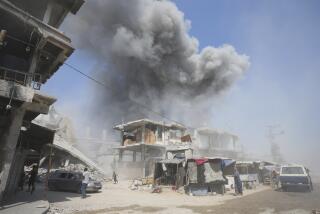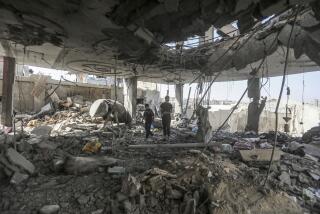Guns Are Silent in Bosnia; Humanitarian Abuses Persist : Balkans: Diplomats, U.N. officials say many provisions of truce are ignored. Reports of atrocities are widespread.
ZAGREB, Croatia — The Bosnian cease-fire has finally quieted guns in the most combative parts of the country, U.N. officials said Sunday. But the humanitarian end of the agreement remains unfulfilled amid reports of executions, atrocities and continued restrictions on the movement of civilians.
U.S. and U.N. officials have accused the Bosnian Serbs of systematic, “horrendous” abuses against Muslims--including possible summary executions--that may have been going on as recently as last week.
The cease-fire agreement, signed by the Serbs and the Muslim-led but secular Bosnian government, went into effect Oct. 12. It is intended to lay the groundwork for a comprehensive peace agreement that the warring parties will negotiate in U.S.-sponsored talks beginning next week in Ohio.
In addition to the military side of the truce, which calls for a suspension of hostilities by both sides, there are provisions for the humane treatment of civilians and the “free passage and unimpeded access” of all non-military traffic on roads between the besieged Bosnian capital, Sarajevo, and the country’s last eastern enclave, Gorazde, as well as “freedom of movement” for “all persons.” These provisions have been largely ignored, according to diplomats and U.N. officials.
“There have been many agreements and many accords, and the humanitarian side is always the weakest and least observed,” said Kris Janowski, an official with the Office of the U.N. High Commissioner for Refugees. “There is no enforcement mechanism.”
*
In the days leading up to the cease-fire, Bosnian Serb paramilitary units in disputed areas around Sanski Most--west of the Serbian stronghold of Banja Luka--rounded up non-Serbian civilians, separated the men and expelled about 6,000 women, children and elderly, according to Janowski and other U.N. and U.S. officials.
The ethnic expulsions were accompanied by rapes and robberies, according to the victims, who eventually reached Bosnian government territory. The men, about 2,000 to 3,000 of them, disappeared, and their whereabouts remain unknown. The fear is that they were press-ganged into forced labor camps or killed.
“Given the totality of the evidence and circumstances, we are very concerned that the systematic killing of men of military age has been or is going on,” a Western diplomat said in Zagreb, the Croatian capital, late last week. “We are very concerned that there is a Srebrenica kind of killing in which Bosnian Serbs are systematically executing military-age men.”
Srebrenica was a U.N.-protected Muslim enclave in eastern Bosnia-Herzegovina that was overrun by the Bosnian Serb army in July.
Tens of thousands of women, children and elderly were brutally expelled, and an estimated 5,000 men were rounded up in a stadium and never accounted for. The U.S. government later released aerial spy photographs purporting to show mass graves in the area, and several survivors have described mass executions of the men. The Bosnian Serbs have denied that.
*
U.N. officials said a wave of expulsions over the last month that has rid Serb-held northern Bosnia of 22,000 Muslims and Croats is part of a “final push” to create an ethnically pure state--a push being accelerated before a peace agreement freezes the status quo.
Similarly, Croatia, while not a signatory to the cease-fire agreement, used a military offensive to force more than 180,000 Serbs from Croatia’s Krajina region. There, Croatian forces have murdered more than 100 mostly elderly Serbs who stayed behind and have torched thousands of homes in a campaign to discourage Serbs from returning, human rights officials say.
An estimated 50,000 Serbs fled an advance this month by the Bosnian government and its Croatian allies in the Sanski Most area and have crowded into Prijedor and Omarska--sites, ironically, of Serb-run detention camps for Muslims at the start of the war.
John Shattuck, U.S. assistant secretary of state for human rights, said last week after interviewing Muslim refugees from the area that the reports of murders and rapes could lead to new and stronger war-crimes indictments against Bosnian Serb leaders.
Shattuck noted what he called “horrendous” human rights abuses and “substantial prima facie evidence of war crimes which, if confirmed, could lead to indictments.”
His report, and a subsequent U.N. report, appeared to corroborate an article in the Los Angeles Times that recounted stories told by refugees from the Sanski Most area. They told of being ordered out of their homes at a few minutes’ notice and of being robbed and beaten, and they said they witnessed men being bludgeoned to death by Bosnian Serb paramilitary forces under the command of notorious warlord Zeljko Raznjatovic.
Raznjatovic, known as Arkan, has close ties to Serbian President Slobodan Milosevic, raising questions about the Serbian leader’s knowledge of the expulsions at the same time he positions himself as key to the U.S.-driven peace initiative.
“We make an urgent appeal to the Bosnian Serb leadership to stop these horrors,” Shattuck said. “There are lives at stake. The lives can be saved.”
*
In the Sanski Most area, Serbs rounded up non-Serbs in street-by-street raids as government troops advanced, Shattuck said. White stripes were painted on Muslim homes, and Muslims were forced to wear white armbands to identify them, he said, citing refugees’ reports.
Shattuck said he received reports of several hundred Muslims killed while being held at a cement factory in Sanski Most. And 100 others were reported killed at nearby Bosanski Novi when they refused Serbian demands that they leave.
The cease-fire was delayed for two days while the Bosnian government continued its offensive in northwestern Bosnia and finally took Sanski Most from the Serbs. Once the cease-fire began, government forces continued to consolidate their gains and refused to allow U.N. monitors into the region.
The United Nations has fought for access, already granted by the Serbs. Meanwhile, free movement for civilians is still restricted along the Sarajevo-Gorazde route.
In violation of the cease-fire agreement, French U.N. peacekeepers last week provided the Serbs with an advance list of the number of cars and people in a convoy headed by the U.S. ambassador to Bosnia, according to U.N. sources.
The following day, when the Serbs protested the inclusion of journalists in the convoys going to Gorazde, the French ordered the journalists removed.
Times special correspondent Laura Silber contributed to this report.
More to Read
Sign up for Essential California
The most important California stories and recommendations in your inbox every morning.
You may occasionally receive promotional content from the Los Angeles Times.











